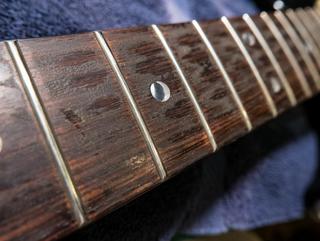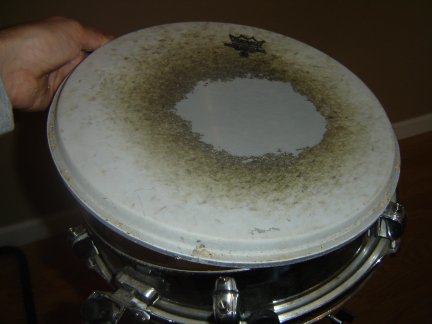THE LITTLE FOXES THAT SPOIL THE VINENothing can make your mix more muddy or cruddy sounding, than poorly maintained instruments. Maybe you were hoping for an article about EQ, compression, or effects? Perhaps you were wanting the coolest fad of an effect or processor to tighten up your mix? Can I just share this with you? The most effective things, are the simple things! Les Paul Needed a Bath  I had this friend of mine come to me for some much needed guitar repair on his 1974 Gibson Les Paul. His complaint, was that his guitar sounded dull and lifeless. He was hoping to replace the pickups and all of the hardware to "brighten it up a little," but I had a much different idea. His problem wasn't any of his hardware, but that his guitar was filthy. His strings (that probably hadn't been changed since the 80's) had caked on dirt and sweat. The fretboard looked a lot like the one in the picture here, but it was far worse. I spent at least 2 hours just cleaning the guitar before changing the strings. Once I gave the guitar back to him, he plugged it in, and was blown away by the difference. He asked me, "what did you do?" I replied, "I cleaned it." The Lars Effect  I was called into a recording session to track some drums. When I walked into the studio, there was this young kid with an attitude setting everything up (the drummer). When he started playing, I noticed right away his drums weren't tuned, his drum heads had zero life left in them, and his drum pedal squeaked. My handy-dandy bottle of 3-in-1 oil solved the squeaking problem, but his drums sounded like he was smacking a set of tupperware lids (I call this the Lars effect). I politely asked him if he had any newer heads. "NO, they're fine," he retorted. I asked him if we could spend some time tuning his set. "No way maaan, it sounds great!" I went to the "producer," and he told me to just roll with it after a long and "polite" conversation. So off we go. We build several tracks on one of the worst sounding drum sets in history (and these were the days before drum replacement). I solved the ringing snare from hades by "georging" it after the band had left for the night, but those toms were irredeemable. Turd in, turd out. You Know Where This is Going Don't You? Upon mixdown, the drummer is missing, and nowhere to be found. He finally comes in two days into the mixing stage, and the first thing he says is, "My drums sound like crap!" Ha Ha! Classic! The Low Down I get called in to do some session guitar work for a worship band several years ago. I set up, get my charts, and off we go rehearsing. The whole rehearsal, something just seems off. I pinpoint the issue is coming from the bassist. No fretless, but I can tell he's slightly sharp the whole time. Once the band takes a break for a little, I check his intonation. Bingo! He's REALLY off on every string. I spend about 20 minutes getting his intonation spot on, and his bass re-tuned. Band comes in from their break, and off we go rehearsing again. This time the band starts clicking, and I hear someone say, "Whoa, for some reason, everything sounds so much better." "THERE IS NO "FIXING IT IN THE MIX"This motto I have carried with me for the last 25 years in engineering. Even nowadays, there is only so much you can do to improve a crappy sounding instrument (and even less, a poor musician). If you are a musician, go through your gear with a fine toothed comb. Stay on top of it at all times. This is called "being professional," and the engineer will love you for it! Are your cables in good working order? Is your instrument properly maintained? Are your drumheads in good shape? Does your amplifier have fresh tubes in it? Do you know how to repair something electronically? These are just a few of the things you need to consider going forward if you are serious about being a musician and/or an engineer.
0 Comments
Your comment will be posted after it is approved.
Leave a Reply. |
Do you like vintage recording gear and articles? You should visit our sister site: The Vintage Audio Portal!
**Advertise With Us! We have thousands of visitors a day. Contact us here to learn more.
Archives
August 2021
Categories |
